Tuesday, May 29, 2007
Hillspring Wildlife Rehabilitation Centre Released 4 Grizzly Cubs-Dawon Creek, BC
History was ‘officially’ made on Weds, May 16, 2007! A North American bear rehabilitor, Leona Green, has successfully raised 4 orphaned grizzly cubs (2 female), taking them from 15-20lbs in July ‘06 to their release weight of well in excess of 100lbs. The bigger size for their age class will give the cub’s a fighting chance with preditory carnivores. The cub’s diet consisted of high protein from donated venison and salmon, grains, veggies and fruit ( including natural berries previously picked and frozen). Leona Green has raised and released two female grizzlies in 1996 but they were not officially counted by the authorities at that time.
Grizzly bear rehabilitation is done in other parts of the world like Russia and Romania but North American authorities have been shy to embrace it for ‘liablity’ reasons ( I believe?). Thanks to some progressive and compassionate Conservation Officers in Northern BC Leona Green was able to help give these four cubs plus two black bears a second chance this year. She has now rehabbed over 100 bears successfully over 30years (not one of the bears have shown up and caused problems).
Girl Scout's become Bear Aware

On a cool weekend in April, a hardy bunch of Girl Scouts (250 of them) gathered in Carnation, WA for their annual encampment event. They built rain shelters, canoed the lake, created works of art and performed skits around the campfire. A highlight was the retiring of an American flag in a special ceremony.
GBOP’s own Julie Hayes lead forest nature hikes for the Brownies, the Junior campers and their parents. Bear safety and biology were on topic, and many thoughtful questions were asked by campers and parents alike. As it turns out, many of the families had experienced some bear activity (mostly in garbage cans) in their neighborhoods. GBOP brochures packed full of useful information on safe camping, hiking and home sanitation were passed out to extend the learning at home.
Monday, May 14, 2007
Bear Affair Weekend

Woodland Park Zoo and GBOP hosted what is quickly becoming an annual event anticipated by both patrons of the zoo and the bears that live there. Keema and Denali, both 950 pound Brown (Grizzly) Bears put on quite a show. With donated equipment from REI, the zoo staff, GBOP and invited members of the public set up a campsite in the bear compound. Everything was done incorrectly to demonstrate what bears can do to your camp if you leave food nearby or worse yet, in your tent.

The bears went thru the camp systematically looking for and finding all of the hidden treats.

In about the same time as it takes to set up camp, the bears had completely demolished everything. People watching the camp destruction quickly understood the value of setting up a proper camp.

Over 2,000 people visited the Bear Affair activities. Everyone enjoyed themselves, but no one had as much fun as Keema and Denali. You can check out a You Tube video of the event at http://www.youtube.com/watch?v=CARM1-ZQYb4.
The GBOP website has lots of tips for living and camping in bear country: http://www.bearinfo.org/tips.htm.
Photo credits by Dennis Ryan and Wendy Gardner
Back Country Horsemen Spring Ride

Each spring members of the Back Country Horsemen of Washington get together at Beaver Creek campground in the Methow Valley to spend a weekend of riding, socializing and general togetherness. This year was no exception. Over 300 folks camped out and had a great time. The official Saturday ride attracted 270 horses and their riders for an eleven mile round trip. A stop at the midway point allowed horses to rest and riders to enjoy a catered steak dinner hosted by the Methow Chapter of the BCH. There are 36 chapters with over 3,000 members in Washington State.

After the ride the care of the horses are the top priority. Kids learn this at an early age. The event was also an opportunity for GBOP to hand out material and discuss bear safety in the back country. If you spend much time in the woods you are likely to encounter bears sooner or later. Back Country Horsepeople share the wilderness that bears call home. The proper safety tips can mean the difference between a fun bear experience and a person-bear conflict.

Looking back on the weekend most of use can't wait till next year.
First Tuesday Presentation

The Methow Conservancy invited GBOP to give a presentation entitled "Bears of the North Cascades and Beyond" at their April First Tuesday event held at the Twisp River Pub. The house was packed as the lights went down and Mary Kiesau introduced Chris Morgan and Dennis Ryan from GBOP.
Chris shared his experiences traveling the world to study bears. From Norway to the Andes, Pakistan to the Rocky Mountains, the audience took a virtual tour of the global state that bears find themselves in today's gloal warming trend.
Dennis followed that act up with a discussion of bears of the North Cascade Ecosystem. Do they indeed exist? What are their numbers, habits and habitat? How can this habitat be protected and the declining number of North Cascade Grizzlies be recovered to a viable population?
A hearty discussion followed the presentation. Obvisouly the public was informed and intested in the plight of Washington's bear population. Many thanks to the Methow Conservancy for hosting the presentation.
Wildlife Highway Crossings
Dr. Tony Clevenger of the Western Transportation Institute at Montana State University has research video cameras that record the passage of a variety of large mammals using Banff National Park’s wildlife crossing structures under the TransCanada Highway. To view video clips of grizzly bear, black bear, mountain lion, elk and deer go to this website:

http://www.coe.montana.edu/wti/road_ecology/whats%20new.php
The Washington Department of Transportation has future plans to build wildlife under passes on I-90 in the North Cascades area.
Thursday, February 15, 2007
REI bear hugs GBOP

Yes, REI has embraced GBOP. Over 140 people gathered at REI recently to listen to a presentation by Chris Morgan, co-director of GBOP.
Chris has traveled the world in search of Brown Bears (aka Grizzly Bears) and the study of the habitats in which they live. His slide show was a virtual feast of wild bears in wild places. From Spitsbergen to Spain, Canada to Russia, bears rule the wilderness. Yet, without exception their habitats are threatened by development and encroachment. Looming on the horizon is the mother of all threats – GLOBAL WARMING. In Spain the bears are not hibernating. In the artic bears rely on sea ice to hunt their major source of food, the seal, and this ice is receding further and further north with each passing year. Soon the sea ice is predicted to disappear entirely in the summer months.
Thinking globally and acting locally has never been more relevant. In the North Cascades ecosystem grizzly bears have declined to the point that less than 20 survive. This is not a population that is likely to survive without help. The North Cascades was designated a grizzly bear recovery zone in 1983 by the US Department of Fish and Wildlife. After the presentation, the audience had many questions concerning recovery plans for North Cascade grizzlies.
GBOP thanks REI for their support in our continuing education programs and for their sponsorship of bear awareness weekends. Mark your calendar for April 21 and 22 to join us at the Woodland Park Zoo where the resident brown bears will be the center of attraction.
Photo credit Dennis Ryan
Wednesday, January 03, 2007
No rest for the weary

Did you know that bears are an umbrella species? The health of a bear population is a reflection of the health of the ecosystem in which they live. Did you know that bears hibernate throughout the winter? Talk about a good nights sleep! Did you know that bears have stopped hibernating in the mountains of northern Spain? This may be one of the strongest signals yet of how much climate change is affecting the natural world.
In a December in which bumblebees, butterflies and even swallows have been on the wing in Britain, European brown bears have been lumbering through the forests of Spain's Cantabrian mountains, when normally they would already be in their long, annual sleep.
Bears are supposed to slumber throughout the winter, slowing their body rhythms to a minimum and drawing on stored resources, because frozen weather makes food too scarce to find. The barely breathing creatures can lose up to 40 per cent of their body weight before warmer springtime weather rouses them back to life.
Please Click here to read the complete article.
Why do we care about sleeping bears? Besides the fact that we might globally warm ourselves right out of existence, unlocking the secrets of hibernating grizzlies may help people live longer and stay healthier.
Mike Stark writes in the Billings Gazette that researchers for years have been trying to understand how the bears survive such a long, slothful period without suffering lasting ill effects.
In particular, scientists are looking at what the napping bears can teach about staving off heart disease, extending the viability of transplant organs and maintaining muscle tone in bedridden patients or astronauts in space.
Much of the research is happening at Washington State University, where 10 captive grizzly bears, some of them from the Northern Rockies, are studied year-round.
Friday, December 29, 2006
How global warming affects Polar Bears

Yes, this is a grizzly bear blog, but did you know that polar bears are very closely related to grizzly bears? They have evolved from brown/grizzly bears only over the last 250,000 years to become one of the most perfectly adapted creatures on the planet.
I guide expeditions to the far north each year to the Norwegian arctic islands of Svalbard - just 600 miles from the north pole. It's an incredible landscape - surely one of the most beautiful in the world. But the most special thing about this isolated jewel is the population of polar bears that call it home. We generally see up to forty polar bears during each 10 day expedition, many of them hunting for ringed and bearded seals on the last remaining ice of the summer months.
2006 saw a surprising lack of summer ice - in fact, the pack was 100 miles further north than an average year, which meant that bears were more densely gathered around the few remaining sections of fast ice. It was a blunt reminder of the effects of climate change. I photographed the female and cubs below as they hunted seals on a quickly-shrinking piece of ice. Polar bears can not hunt successfully without ice - access to the prized ring seals generally happens in one of two ways - lying in wait over a seal's breathing hole, or stalking across the ice in a surprise attack. Once the winter ice has disappeared the bears have no option but to rest up and conserve as much energy as possible until the winter months bring back their icy hunting substrate.

Climate change is warming the arctic environment at an unprecedented rate meaning that the period of ice-free months is
lengthening. This puts incredible strain on the metabolism of a polar bear that is waiting for a meal. Incredibly, they can go for months without eating a seal, but as the days grow warmer, the polar bears are increasingly affected. For example, research by Dr Ian Stirling and Dr Nick Lunn in Hudson Bay has shown that for every additional week that a polar bear is land locked (away from the hunting substrate of the ice) it is 10 kilograms (22 pounds) lighter! Let's hope that today's proposed listing of polar bears on the endangered species act will help secure a future for this species.
Polar Bears Listed as Threatened

Excepts from an article written by Juliet Eilperin
Washington Post Staff Writer
Wednesday, December 27, 2006; A01
The Bush administration has proposed listing the polar bear as threatened under the Endangered Species Act, putting the U.S. government on record as saying that global warming could drive one of the world's most recognizable animals out of existence. There are 20,000 to 25,000 polar bears worldwide, 4,700 of which live in Alaska and spend part of the year in Canada and Russia. The other countries with polar bears in their Arctic regions are Denmark (Greenland) and Norway.
Identifying polar bears as threatened with extinction could have an enormous political and practical impact. Because scientists have concluded that carbon dioxide from power-plant and vehicle emissions is helping drive climate change worldwide, putting polar bears on the endangered species list raises the legal question of whether the government would be required to compel U.S. industries to curb their carbon dioxide output.
This move stems from the fact that rising temperatures in the Arctic are shrinking the sea ice that polar bears need for hunting. Northern latitudes are warming twice as rapidly as the rest of the globe, according to a 2004 scientific assessment, and by the end of the century annual ocean temperatures in the Arctic may rise an additional 13 degrees Fahrenheit. As a result, researchers predict that summer sea ice, which polar bears use as a platform to hunt for ringed seals, will decline 50 to 100 percent.
The ice in Canada's western Hudson Bay breaks up 2 1/2 weeks earlier than it did 30 years ago, giving polar bears there less time to hunt and build up fat reserves that sustain them for eight months before hunting resumes. As local polar bears have become thinner, female polar bears' reproductive rates and cubs' survival rates have fallen, spurring a 21 percent population drop from 1997 to 2004. Polar bears normally swim from one patch of sea ice to another to hunt for food, but they are not accustomed to going long distances. In September 2004, government scientists observed 55 polar bears swimming offshore in the Alaskan Beaufort Sea, an unprecedented spike, and four of those bears died. In a separate study that year, federal scientists identified three instances near the Beaufort Sea in which polar bears ate one another.
Footnote: Researchers disclosed today that a giant chunk of the Canadian Ice Shelf has recently fallen into the ocean. This shelf has shrunk by 90% since the 1930s. Food for thought!
Tuesday, December 12, 2006
Many people ask about the difference between grizzly bears and brown bears. Technically, the difference is very small. Both species are Ursus arctos (as with all brown bears around the world), but the grizzly bear is a sub-species of the North American brown bear which means that its full scientific name is Ursus arctos horribilis. Generally speaking, if you get to within 100 miles of the coast, people start referring to this species as a 'brown bear', otherwise 'grizzly bear' is the way to go.
Another key difference between the two is behavioral. It seems that coastal brown bears have an incredible and surprising ability to tolerate human presence - sometimes at very close quarters. I escort small groups of bear fans to the Katmai coast of Alaska every year and I am always astounded at the viewing opportunities that they provide for us. A great example of this is below - a picture of a female brown bear and her yearling cub - sleeping eight feet away (yes, those are my boots in the foreground!).
.jpg)
However, as I've spent my career teaching about bear conservation and how to behave around bears I'm compelled to share a note about these coastal brown bears and the context of the photograph above. The brown bears in this picture are on the coast of Alaska where thick runs of salmon mean that these normally solitary animals have become quite tolerant of each other over a rich food resource. In certain situations, they seem to extend that tolerance to humans, and will frequently come quite close to people during their everyday feeding activities. This is very different behavior to grizzly/brown bears (Ursus arctos) in the interior (e.g. Denali, Yellowstone, Glacier, North Cascades etc), where a much larger safety buffer is advised, and where bears don't generally become this human-habituated over rich food resources.
Generally speaking, close-up interactions with bears should be avoided at all cost (Wildlife + Distance = Safety). In Katmai, the Park Service rules sensibly stipulate that people should not approach closer than 50 yards to any bear, or 100 yards for females with cubs. Sometimes though, the bears have other ideas! In the case above the female and cub settled down calmly next to us for a sleep, and there were an additional 23 bears within 100 yards of us at the time! Our calm, calculated response to their approach helped to ensure safety for the bears and the people.
Brown or grizzly? Either way, interactions with bears can vary immensely and a knowledge of bear behavior is essential when determining the best course of action.
For more information on bear safety, please go to the GBOP website: www.bearinfo.org/bearsafety.htm
Written by Chris Morgan, GBOP Co-Director, bear researcher & conservationist chrismorgan@insightwildlife.com
Monday, December 11, 2006
Ranchers and Grizzlies can coexist!

A recent article appeared in the winter 2007 issue of ‘On Earth’ magazine profiling Montana ranchers working to protect and live with Grizzly Bears.
The Madison valley is located just 40 miles northwest of Yellowstone National Park. The area is a cross section of the new west; cattle ranchers, second home owners and a rebounding Grizzly Bear population. Grizzly Bears in this region may be de-listed under the Endangered Species Act.
Rancher Todd Graham is working with local neighbors to ensure the conservation of the biggest predator in the valley, the Grizzly Bear.
Click here to read the full article.
The article was written by Bruce Barcott, photo credits : Vern Evans
Kids in the Hood
Wednesday, December 06, 2006
Are you Bear Smart?
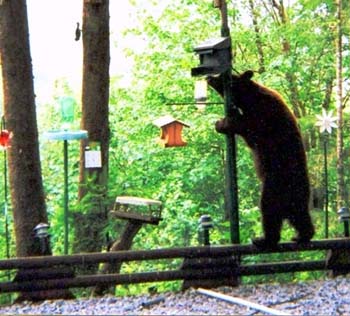
Did you know that bird feeders are powerful bear attractants? They love black sunflower seeds like we love ice cream. Or that compost and fruit on the ground can draw a bear from a mile away? And that unsecured garbage cans full of rotten food are an open invitation for bears to dine?
A bear that hangs around your house, farm or business becomes conditioned to human food and the presence of humans. They lose their fear of people and human-bear conflicts are inevitable. Once a bear becomes a problem they cannot be relocated and are often killed. “ A feed bear is a dead bear” so the saying goes.
GBOP developed the ‘Bear Smart Program’ to provide folks with the information necessary to ensure the safety of humans and the welfare of bears. You are invited to apply for ‘Bear Smart Certification’ by visiting the GBOP Bear Smart website www.bearinfo.org/bearsmart.htm.
Some bear smart tips include: pick ripe fruit from trees, feed birds in the winter when the bears are hibernating, don’t leave pet food outside, secure your garbage in a safe area or use a bear smart container. Enjoy the presence of bears without making them a nuisance.
photo credit: Jim Frick
written by Dennis Ryan; GBOP Okanogan County Field Coordinator
Tuesday, December 05, 2006
Skagit Valley Poster Contest
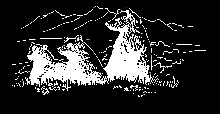
Kids love wild animals, and bears are no exception. This fall the GBOP's Bear Smart Program sponsored the Upper Skagit Bear Smart Poster Contest for students living within Concrete School District. Chris Morgan, GBOP Co-Director, and Nan Laney, Skagit and Northern Snohomish Coordinator, kicked off interest in the poster contest during two assemblies at the Concrete Elementary School in late October.
The assemblies were great fun for all, and the kids left with a lot of enthusiasm for participating in the contest. There were about 40 posters submitted by students Kindergarten through 6th grade. Not surprisingly, there were many creative and artistic perspectives on how we can avoid conflicts with our resident black bear population (which is the focus of GBOP's Bear Smart Program). This was our first poster contest and we look forward to further developing and expanding the poster
contest, as well as our relationships with kids, families and teachers in the coming years.
The best posters will be posted on this BLOG after the contest is complete.
Submitted by Nan Laney, Skagit and Northern Snohomish Field Coordinator
GBOP expands

Nan Laney, who has worked as the Skagit and Whatcom County Field Coordinator located in Washington State for the past 3 years, has recently moved her working area south to include the northwest part of Snohomish County -- the North and South Fork Stillaguamish Valleys that include Darrington and Granite Falls. Whatcom County efforts have been passed off to Jim Davis, GBOP Co-Director, who is spearheading a focused Bear Smart program in the town of Glacier, which is surrounded by the Mt Baker-Snoqualmie National Forest and excellent black bear habitat.
In September, about 15 eastern Skagit and Whatcom community members who are involved in the GBOP's educational efforts joined GBOP staff on our second field trip to the Woodland Park Zoo for a weekend bear awareness event. These trips are wildly popular and attendees often reflect enthusiastically about the zoo trip at GBOP Community Group meetings for months afterwards. Our last zoo trip was in the spring of 2005, and we are working collaboratively with the Woodland Park Zoo to plan a 3rd bear awareness event for the spring of 2007.
Submitted by Nan Laney, Skagit and Northern Snohomish Field Coordinator
Monday, December 04, 2006
Grizzly Bear Sighting
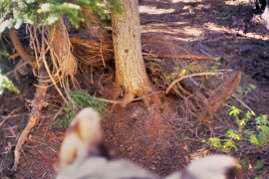
In the North Cascades there are approximately 6,000 Black Bears and less than 20 Grizzly Bears. Grizzly sightings generate a lot of excitement due to their rarity. When a credible Grizzly Bear report is received, efforts are made to verify the accuracy and to follow up and locate the bear.
This August a possible ‘Class I’ sighting of a Grizzly mom and her two cubs was reported in the Glacier Peak wilderness area. Sighting reports are rated by their credibility, accuracy and qualifications of the reporting party. A ‘Class I’ sighting is the highest rating and is most likely a Grizzly Bear. Final status of this sighting has not yet been determined.
The folks at Conservation Northwest sent a team to the sighting area to place a remote operated camera in the hopes of capturing photos of the Grizzly family. It was a long shot. Grizzly moms can move around within a 250 square mile area. Though the Grizzlies did not show up for a photo shoot, some other animals posed for the camera. The photo above is a cute pair of Black Bear ears.
A rare visit by a Wolverine was captured by the camera and was the highlight for the team. These elusive animals are seldom seen in the wild.
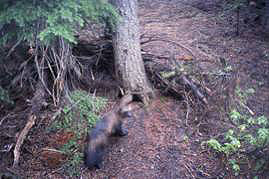
Core wilderness areas are teaming with wildlife. When you are out hiking, animals are aware of your presence and stay clear. When you place a secret camera, the real show begins. Many thanks to Conservation Northwest for their efforts in obtaining these photos.
Written by Dennis Ryan, GBOP Okanogan County Field Coordinator.
Monday, November 13, 2006
Summer Friend
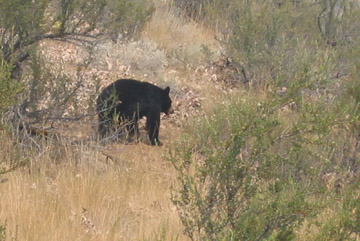
As I look out my window at the first snowfall of the year, I wonder where my summer friend has chosen to spend the next five months sleeping. Our property borders the Okanogan National Forest and was home to this bear throughout the spring, summer and into early fall.
We coexisted quite easily by respecting each other’s space. The terrain is shrub-steppe. There is plenty of food for the bear including lots of succulent plants and grasses, grubs and insects, apple orchards, huckleberries and service berries. Both the hard winter and the coyotes left plenty of winter killed deer carcasses for the bear to replenish nutrients during the first few weeks after the bear emerged from the den.
I keep a tidy house so that compost, pet food, bird food and garbage does not attract the bear and create a conflict situation. My dogs have also been trained not to chase deer or bears. Alas, they do occasionally go after a chipmunk.
Throughout the season the bear and I ran into each other. My wife and I spend a lot of time riding horses and walking dogs on the forest service land. Usually the dogs or the horses would ‘alert’ to the bear before we were aware of its presence. That’s a handy tip to keep in mind when you walk in the woods. By watching the body language of your pets, they will alert you to the presence of other animals and people nearby. My Australian Cattle Dog has a special bark that he only uses for bears. I snapped this photo of the bear after I noticed my horse looking intensely up the hill as the bear worked it’s way down the slope behind our house.
When I see the bear I wave slowly and say “Hi Bear” loudly. This lets the bear know that I am human. Usually, the bear stands up to get a good look at me. We both go about our business giving each other plenty of space.
written by Dennis Ryan, GBOP Okanogan County Field Coordinator
Sunday, October 29, 2006
Two Orphans

Two orphaned Brown Bears, also known as Grizzly Bears, live at the Woodland Park Zoo in Seattle. These brothers grew up in a research facility. When the Woodland Park Zoo created the new Brown Bear habitat exhibit, these two brothers got a new home. Today Denali and Kima are nine years old. They love their new home and the Woodland park staff love them.
Recently the staff hosted a bear awareness weekend and invited GBOP to participate. Visitors to the zoo are always fascinated by the bears. With them as the focus it was easy to interest people in learning about the history, biology and recovery efforts of Grizzly Bears in the lower 48 states. Only about 1000 bears are left where once roamed up to 100,000.
Denali and Kima had their role in the bear awareness program. They were given the job of teaching the public how to set up a safe camp in the back country that will not attract bears and create bear-human conflicts. Their method of education? Set up an unsafe campsite and show the public what happens next. With the help of REI, who donated camp equipment, the Zoo staff set up a camp right in the middle of the bear exhibit. Food was left in the tent. Supplies were not hung correctly in a tree. A cooler was set out full of leftovers. The tent was pitched next to the cooking fire.
The bears, who were not present during the set up, were let loose to have at it. In less than 20 minutes the camp was completely destroyed and the bears had a free meal. Bears are incredibly intelligent and curious. Once they learn how to get an easy meal, the next camper that comes along is an easy target. REI will not be using that camp equipment again.
The next task was to give the bears a Bear Resistant Food Container (BRFC) full of goodies that the bears would want. To the delight of the 900 pound bears the containers were resistant, but not bear proof. Soon the bears were enjoying a tasty snack. The crowd went wild when the BRFC broke open. Denali and Kima made everyone think about how to set up a safe camp in bear country.
Photo credit: Ryan Hawk, Woodland Park Zoo
written by Dennis Ryan, GBOP Okanogan County Field Coordinator


